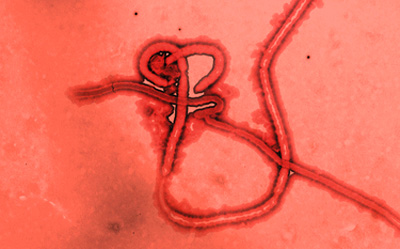Gamma interferon protects mice from Ebola
Posted: 19 November 2015 | Victoria White
A new study suggests that gamma interferon, which is an FDA-approved drug, may have potential as an antiviral therapy to prevent Ebola infection when given either before or after exposure to the virus…


A new study suggests that gamma interferon, which is an FDA-approved drug, may have potential as an antiviral therapy to prevent Ebola infection when given either before or after exposure to the virus.
The study, led by University of Iowa (UI) virologist Wendy Maury, PhD, found that gamma interferon, given up to 24 hours after exposure, can inhibit Ebola infection in mice and completely protect the animals from death.
Ebola infection appears to be a stepwise process. First, the virus targets and infects macrophages or dendritic cells, two types of immune system cells found in the liver, spleen, and lymph nodes. Ebola then replicates in those cells. Following this initial infection, which happens at day 3 or 4 in non-human primates, Ebola virus is released into the blood and infects a plethora of other different cell populations.
“It goes from an early stage with a very targeted infection of only these few cell types, to everything being infected,” explains Maury, who is a professor of microbiology in the UI Carver College of Medicine. “We think what’s happening with gamma interferon is that it’s targeting macrophages and blocking the infection of those initial cell targets so you don’t get the second round of infection.”
Gamma interferon blocks virus replication in cells
The team showed that gamma interferon inhibits the virus’s ability to infect human and mouse macrophages, in part by blocking virus replication in the cells. The researchers then showed that pretreating mice with the drug 24 hours before exposure protects the animals from infection and death. To their surprise, the researchers found that treatment up to 24 hours after what would have been a lethal exposure also completely protected the animals from death, and the scientists could no longer detect any Ebola virus in the mouse cells. These findings suggest that interferon gamma may be useful both as a prophylaxis and post-exposure treatment against Ebola.
The team still has to determine how late the drug can be given to the mice and still prevent infection. However, the results suggest a window of time after exposure when gamma interferon may be an effective antiviral therapy
“My guess is that if you delay the gamma interferon too much, you miss this window of opportunity to block the infection in macrophage cells and the gamma interferon can no longer provide protection,” Maury says.
Researchers plan to study the treatment in conjunction with other antivirals
The UI team investigated how gamma interferon might be helping the cells fight off Ebola virus. They identified that expression of more than 160 genes in human macrophages are stimulated by gamma interferon. Introduction of some of these genes into cells was sufficient to prevent Ebola infection.
“This mechanistic information might suggest more precise drug targets rather than the broad effects, including adverse side-effects, that are produced by gamma-interferon,” Maury says.
In addition to moving the studies into larger animal models, Maury now plans to study the ability of the treatment to inhibit Ebola infection in conjunction with other developing antivirals.
“Right now there are no FDA-approved antiviral therapies for Ebola, but there are some being developed that target virus entry,” she says. “We know that gamma interferon blocks replication but not entry into cells. So combining an entry inhibitor with gamma interferon may allow us to reduce amount of gamma interferon needed and target two different steps in the virus’s life cycle, which has been shown in HIV to be critically important for controlling virus.”
Related organisations
Iowa University



